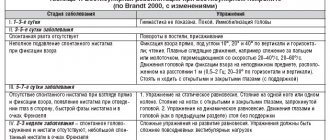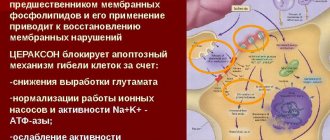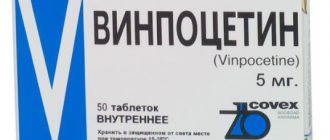Pharmacodynamics and pharmacokinetics
Pharmacodynamics
An artificial analogue of histamine . The effect of betahistine has not been fully studied. There are only a number of hypotheses confirmed by clinical data:
- active substance – partial stimulator of H1-histamine receptors and blocker of H3-histamine receptors of the vestibular centers of the nervous system; improves histamine metabolism and its release due to the above properties;
- betahistine increases blood circulation in the inner ear, relaxing vascular sphincters in this area, and also enhances microcirculation in the brain;
- betahistine stimulates restoration of vestibular function after vestibular neurectomy in animals and humans;
- dose-dependently reduces the generation of impulses in neurons of the vestibular nuclei.
The therapeutic effect of betahistine was demonstrated in patients with Meniere's syndrome and vestibular vertigo , which was expressed by a decrease in the severity and frequency of dizziness .
Pharmacokinetics
When taken orally, the active substance is actively absorbed from the intestine and is almost completely transformed to form a derivative of 2-pyridylacetic acid. The content of betahistine in the blood is low.
Concomitant food intake may slow down the absorption of betahistine. Reaction with blood proteins does not reach the 5% barrier. The maximum concentration of 2-pyridylacetic acid in the blood occurs 1 hour after consumption. The half-life is approximately 3 and a half hours.
The metabolite is actively evacuated in the urine. Excretion of betahistine itself through the kidneys or intestines is negligible.
What are they prescribed for and how do they work?
We often use antihistamines to treat allergic reactions. However, histamine, in addition to participating in immunological reactions, is a substance that regulates various brain functions. Histamine and its three types of receptors (H1, H2 and H3) are widely represented in the vestibular system, therefore antihistamines and histamine-like drugs are recognized as effective in the treatment of vertigo.
30 tab. (Russia)
Betahistine is a structural analogue of histamine that has been used as a medicinal agent for about 40 years. It has been established that betahistine acts differently on histamine receptors:
- is a weak H1 agonist (repeats the action of histamine),
- is a strong H3 antagonist (acts opposite to histamine),
- has virtually no effect on H2.
The multidirectional effect of betahistine on H-receptors determines the variety of its biological effects, which include:
- increased cochlear blood flow,
- vasodilation of peripheral vessels,
- increased vascular permeability and decreased blood pressure,
- impact on sensory cells of the vestibular apparatus,
- increased histamine synthesis in histaminergic neurons,
- changes in the excitability of neurons of the vestibular system.
Thus, the effect of betahistine is not limited to the effect on the blood supply to the vestibular apparatus. It turned out that it is just as effective in the treatment of vestibulopathies not associated with vascular insufficiency. It is usually well tolerated and rarely causes unwanted side effects. In addition, it is devoid of sedative effects.
A recent study showed that honey. preparations containing betahistine are an indispensable component of treatment protocols for Meniere's disease and other vestibulopathies in European clinical practice and are prescribed in 94% of cases.
In a double-blind, randomized study conducted recently in 11 clinics in Italy, 144 patients with peripheral vestibular vertigo were observed. One group received a placebo for 3 months, and the other received 8 mg of betahistine twice a day. Clinician ratings of treatment were very good in 74% of patients taking the drug, compared with 27% of patients taking placebo.
The effectiveness has been confirmed in other studies. In 293 examined patients with Meniere's disease, symptoms of dizziness disappeared altogether or the frequency and intensity of attacks decreased in 93% of patients when taking 16 mg of betahistine three times a day for 3 months.
Vestibulopathy associated with dizziness is a serious problem. You will be surprised, but there are more than fifty reasons that cause the symptom of dizziness (vertigo). Nausea and vomiting as accompanying symptoms are also common. Is there a way to get off this “carousel” and finally feel that the world around you no longer revolves around you?
Treatment of such diseases usually proceeds in two stages. At the first stage, the patient is offered vestibular suppressants that block vertigo, after which they move on to the stage of compensation for disorders and rehabilitation of the vestibular apparatus. It is at this stage that the drugs Betahistine and Betaserc can be used. Let's look at their main properties and differences.
Both drugs belong to the same pharmacological group, because they basically contain the same active ingredient betahistine
. Since these drugs are analogues, the question of how Betaserc differs from Betahistine can only be attributed to the manufacturer.
We recommend reading: When is a mixture of ground feed given to broilers?
Betaserc is produced in the form of tablets of 8, 16 and 24 mg by Abbott Healthcare Products BV (Netherlands or France). Betahistine in the same form and dosage is produced in Russia at many pharmaceutical sites, including Kanonpharma Production ZAO, VERTEX, North Star.
Indications for use of Betaserc
Indications for use of Betaserc:
- Meniere's disease;
- vertebrobasilar insufficiency , atherosclerosis of the cerebral arteries , post-traumatic encephalopathy (as a component of complex therapy);
- syndromes characterized by tinnitus, increasing hearing loss, dizziness , including hydrops of the inner ear , labyrinthine and vestibular disorders, labyrinthitis , vestibular neuritis, benign positional vertigo.
Contraindications for use
The use of Betaserc is contraindicated for diseases such as:
- pheochromocytoma;
- bronchial asthma;
- acute phase of gastric ulcer and duodenal ulcer.
We recommend reading: How sugar is indicated in a blood test - deciphering a blood test for sugar
Do not take the product during the first trimester of pregnancy. The drug is also contraindicated for persons with individual intolerance to the components of the drug.
Betaserc is cautiously prescribed to women during the second and third trimester of pregnancy, pediatric patients, and people with a history of gastric and intestinal ulcers. The drug is contraindicated during breastfeeding due to the fact that it is currently unknown whether the active substance is excreted in breast milk
The drug is contraindicated during breastfeeding because it is currently unknown whether the active substance is excreted in breast milk.
Betaserc tablets, instructions for use (Method and dosage)
The medicine is prescribed to be taken orally with meals. The dosage is selected individually, taking into account the response to therapy.
The daily dose for adults is usually 24-48 mg, divided into 2-3 doses. The 16 mg or 24 mg tablet is easy to split. To do this, place the dosage form on a hard surface with the notch facing up and press firmly on it with your finger.
Sometimes the drug shows its effect only after 2-3 weeks of treatment, and a confident therapeutic effect develops after several months of constant use. No dosage adjustment is required in elderly patients.
Possibilities of using the drug Betaserc in clinical practice
About the article
13884
0
Regular issues of "RMZh" No. 10 dated May 20, 2006 p. 774
Category: General articles
Author: Teplova N.V. 1 1 Federal State Autonomous Educational Institution of Russian National Research Medical University named after. N.I. Pirogov Ministry of Health of Russia, Moscow, Russia
For quotation:
Teplova N.V. Possibilities of using the drug Betaserc in clinical practice. RMJ. 2006;10:774.
A fairly common complaint, especially among older people who come to consult a doctor, is dizziness. For any specialist, and especially for a therapist, a patient complaining of dizziness is an intractable problem. Dizziness is one of the most common symptoms encountered in medical practice. Among the reasons for visiting doctors of various specialties, dizziness accounts for 3–4%. Thus, according to Yardley L. (1998), in a survey of more than 20 thousand people aged 18 to 64 years, it was found that more than 20% experienced dizziness within a month, of which more than 30% suffered from dizziness for 5 years. Dizziness occurs in 30% of people over 65 years of age and in 50% of people over 80 years of age. In most cases, dizziness leads to a decrease in the patient’s quality of life, often making him dependent on outside help, causing permanent disability and can even cause disability. In this regard, the problem of treating patients suffering from dizziness is becoming increasingly relevant not only medically, but also socially.
Dizziness develops as a result of an imbalance of sensory information coming from the main afferent systems that provide spatial orientation - proprioceptive, visual and vestibular. In addition, disorders of central information processing and the efferent part of the motor act are of great importance. The complex structure of the vestibular system with the presence of numerous receptors in the periphery, their extensive connections with the central nervous system and its high sensitivity to various pathological processes explain the polymorphism of complaints presented by patients and the difficulties in diagnosing and treating vestibular disorders encountered by the doctor. What is dizziness? This seemingly understandable term hides a wide variety of sensations. Sometimes patients call dizziness a feeling of lightheadedness, impending loss of consciousness, or instability. However, vertigo is an illusion of movement of the person himself or the surrounding objects around him; in other words, dizziness is a violation of the spatial orientation of the body, incorrect awareness of body position or movement. Dizziness is a symptom of a large number of diseases, both benign and life-threatening. There are vestibular (true or systemic) and non-vestibular (non-systemic) vertigo. The causes of dizziness are varied. Establishing the cause of dizziness is a very important task for practicing physicians, since it provides the possibility of carrying out etiopathogenetically based treatment and choosing adequate treatment tactics. The most famous classification of the causes of dizziness was proposed by GR Holt and JR Thomas (1980). According to this classification, the main etiological factors include: – diseases of the middle and inner ear of an inflammatory and non-inflammatory nature; – diseases of the central nervous system; – lesions of the neck organs, degenerative-dystrophic changes in the cervical spine; – metabolic and hematological reasons; – cardiogenic disorders; – disorders caused by medicinal substances; – infectious lesions; – other reasons. Vestibular vertigo is caused by organic damage to the peripheral (labyrinth, vestibular-cochlear nerve) and central (cerebellum, brain stem) parts of the vestibular analyzer. Non-vestibular dizziness requires mandatory consultation with a specialist, since its symptoms (presyncope, fainting) may hide serious prognostic diseases: rhythm disturbances, heart defects, myocardial infarction. Causes of non-vestibular dizziness also include anxiety and depressive disorders. Balance disorders of non-vestibular origin are usually caused by organic damage to the central nervous system. The results of clinical and epidemiological studies, the purpose of which was to determine the prevalence of various types of vestibular disorders among patients who came to see a therapist, showed that about 70% of patients reported a feeling of instability, emptiness in the head, “sinking through,” “fog in the head,” "inability to stand on one's feet." Obviously, these complaints do not meet the criteria for vestibular or true dizziness, which is characterized by a clear direction of movement, a sensation of rotation of one’s own body or surrounding objects, often accompanied by vegetative manifestations (nausea, vomiting, hyperhidrosis). An examination of patients who came to see a therapist and presented with complaints that do not meet the criteria for true vestibular vertigo shows that their vestibular disorders are caused by disturbances in nervous activity (dyscirculatory encephalopathy, polyneuropathy, vertebrobasilar insufficiency), cardiovascular (heart rhythm disturbances, heart failure), endocrine systems (hyperthyroidism, hypothyroidism, diabetes), visual impairment (myopia), anemia. The clinical experience accumulated to date convincingly proves that adequate pathogenetic treatment of these diseases leads to a significant reduction in vestibular complaints in this group of patients. When examining patients complaining of severe dizziness, the main causes were transient ischemic attacks in the vertebrobasilar arteries, Meniere's disease, hypertensive crisis, stroke, and discirculatory encephalopathy. The most common cause of vestibular disorders, according to practicing therapists, is discirculatory encephalopathy caused by hypertension and atherosclerosis. The second cause of vestibular disorders is insufficiency of cerebral circulation in the vertebrobasilar arteries, which occurs as a result of osteochondrosis of the cervical spine. The most likely cause of such dizziness is not a sharp decrease in cerebral blood flow caused by extravasal compression of the vertebral arteries, but a mismatched flow of information from the cervical proprioceptors. It has been proven that with age, the mechanoreceptors of the afferent systems undergo degenerative changes and movements in the joints of the cervical vertebrae and discs altered by osteochondrosis, as well as the resulting muscular-tonic syndrome, contribute to the development of inadequate afferent impulses, which causes a feeling of dizziness. In addition, age-related farsightedness leads to spatial disorientation and an additional aggravation of the mismatch of information received from the visual analyzer and neck receptors to the central nervous system. Another cause of peripheral vestibulopathy is benign paroxysmal positional vertigo, which develops mainly in elderly patients and in patients with concomitant metabolic disorders (urolithiasis, cholelithiasis, dyslipidemia) or as a result of traumatic brain injury. In addition, acute and chronic ear diseases (otitis media, labyrinthitis, Meniere's disease) are often possible causes of dizziness. There is no doubt that treatment of dizziness should first of all be aimed at eliminating the cause that caused it. But often the causes of dizziness are not always clear and easy to eliminate. Consequently, pathogenetic and symptomatic treatment becomes of primary importance in the treatment of patients with dizziness. The accumulated clinical experience convincingly proves that the drugs currently offered for the treatment of patients with dizziness belong to different pharmacological groups and have different effectiveness and tolerability. There is still no clear picture in understanding the mechanisms of the vertigolytic action of the main widely used drugs. Often, doctors of various specialties prescribe medications for a long period of time that suppress the compensatory adaptation mechanisms of the vestibular system (antihistamines, tranquilizers, antidepressants, anticholinergics), which significantly complicates further non-drug rehabilitation of patients suffering from dizziness. The most effective treatments for dizziness are those that act at the level of vestibular receptors or central vestibular structures. Impulse transmission in the central part of the vestibular analyzer is provided primarily by histaminergic neurons. In recent years, betahistine dihydrochloride (Betaserc) has been successfully used to relieve dizziness, as well as to prevent attacks. Betaserc, having a structural similarity to histamine, stimulates H1 receptors and blocks H3 receptors, which leads to normalization of nerve impulse transmission in the central part of the vestibular analyzer. The drug is recommended in a daily dose for adults of 48 mg in two doses. At the time of an attack, taking 2-3 Betaserc tablets helps relieve dizziness. For treatment and prevention, Betaserc is prescribed 24 mg (1 tablet) 2 times a day. Betaserc has established itself as a drug that reduces the intensity and duration of attacks of dizziness, improves balance and coordination of movements, reduces the severity of autonomic disorders, helps reduce tinnitus and improve hearing. The undoubted advantages of Betaserc include: its high efficiency and good tolerability during long-term monotherapy, compatibility with other drugs, which is especially important for elderly patients. The drug does not affect blood pressure and heart rate and is not addictive. Betaserc does not have a sedative effect, therefore it does not interfere with the development of vestibular compensation, which is especially important in chronic cases of dizziness. Betaserc has 30 years of experience in clinical use and is registered in more than 80 countries as a highly effective treatment for dizziness of various etiologies. Literature: 1. Alekseeva N.S. // Proceedings of the symposium “Dizziness: modern approaches to solving the problem” of the 8th Congress of Neurologists of Russia. – M. – 2001. – p. 2–5. 2. Vereshchagin N.V. // Consilium medicum. Application. Dizziness. – 2001. – p. 13–18. 3. Fedin A.I. // Proceedings of the symposium “Dizziness: modern approaches to solving the problem” of the 8th Congress of Neurologists of Russia. – M. – 2001. p. 6–9. 4. Martin J. Burton. // Attending doctor. – 1999. – No. 4. – pp. 58–60. 5. Oosterveld WJ // IMN. – 2000. – No. 1. – P. 2. 6. Yardley L. // Behav. Res. Ther. – 1998. – Vol.33, No. 4. – P. 435–439.
Content is licensed under a Creative Commons Attribution 4.0 International License.
Share the article on social networks
Recommend the article to your colleagues
Betaserc's analogs
Level 4 ATX code matches:
Betagis
Stugeron
Betaver
Westinorm
Westicap
Betagistine
Tagista
Vestibo
Cinnarizine
- Betagistine
- Alfaserk
- Microzer
- Asniton
- Betaver
- Betacentrin
- Vertran
- Vestibo
- Westinorm
- Westicap
- Denoise
- Vazoserk
- Tagista (Russian equivalent)
The price of Betaserc analogues is noticeably lower than the price of the described drug.
Betaserc and its analogues (the vast majority) contain betahistine as an active substance, so their indications and contraindications will be identical.
Which is better: Betaserc or Betahistine?
Betahistine and the described drug are analogues with an identical active component. Their indications and contraindications are also the same. The choice should be made based on economic feasibility.
Betaserk or Vestibo – which is better?
Vestibo is a cheaper analogue of Betaserc with almost the same composition. The choice between these drugs should be made for reasons of economic feasibility.
Tagista or Betaserk – which is better?
Tagista is the Russian analogue of Betaserk. The main difference is the price: Tagista rightfully takes the place of the most affordable medicine containing betahistine.
Betaserk price, where to buy
The price of Betaserc 24 mg No. 20 on average in Russia is about 500 rubles, and the drug with a dosage of 16 mg No. 30 is 600 rubles.
In Ukraine, the price range is wide: a package of medicine with a dosage of 16 mg No. 30 can be bought for about 400 hryvnia.
- Online pharmacies in RussiaRussia
- Online pharmacies in UkraineUkraine
- Online pharmacies in KazakhstanKazakhstan
LuxPharma* special offer
- Betaserc tablet.
24 mg 20 pcs 950 rub. order
ZdravCity
- Betaserc tab. 24 mg No. 60 JSC Veropharm
RUB 1,276 order
- Betaserc tab. 16mg No. 30AO Veropharm
RUB 613 order
- Betaserc tab. 24mg No. 20AO Veropharm
RUR 556 order
- Betaserc Long tablets 48 mg 28 pcs. JSC Veropharm
RUB 1,132 order
- Betaserc Long tablets 48 mg 56 pcs. JSC Veropharm
RUB 2,378 order
Pharmacy Dialogue
- Betaserc tablets 24 mg No. 20Abbot
RUR 552 order
- Betaserc tablets 16 mg No. 30Abbot/Veropharm
RUR 626 order
- Betaserc tablets 8 mg No. 30Abbot/Veropharm
RUR 429 order
- Betaserc tablets 16mg No. 30Maylan
RUR 628 order
- Betaserc tablets 24 mg No. 60 Maylan
RUB 1,255 order
show more
Pharmacy24
- Betaserc 8 mg N30 tablets Abbott Healthcare SAS., France
376 UAH order - Betaserc 16mg N30 tablets Mylan Laboratories SAS, France
423 UAH. order
PaniPharmacy
- Betaserc tablets Betaserc tablets 24 mg No. 20 France, Mylan Lab.
418 UAH. order
- Betaserc tablets Betaserc tablets 16 mg No. 30 France, Mylan Lab.
429 UAH. order
- Betaserc tablets Betaserc tablets 8 mg No. 30 France, Mylan Lab.
432 UAH. order
show more








